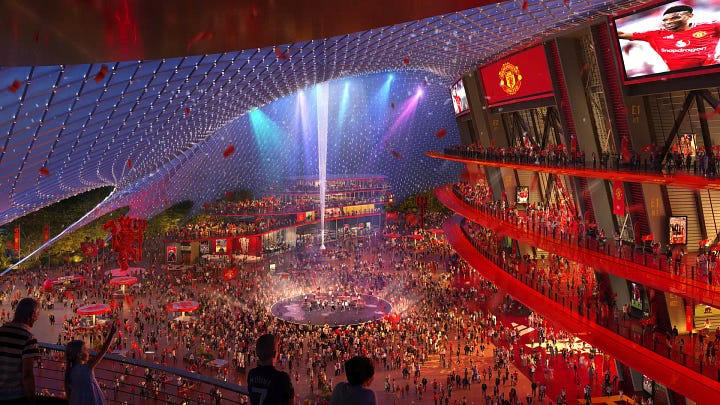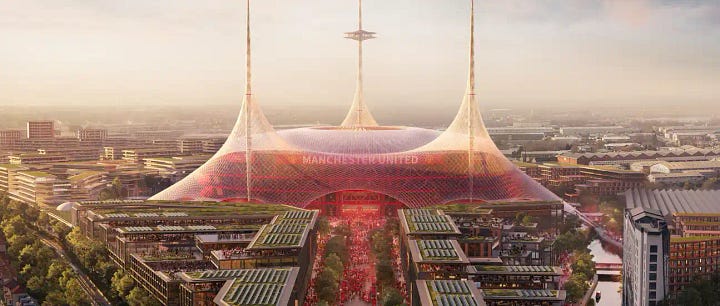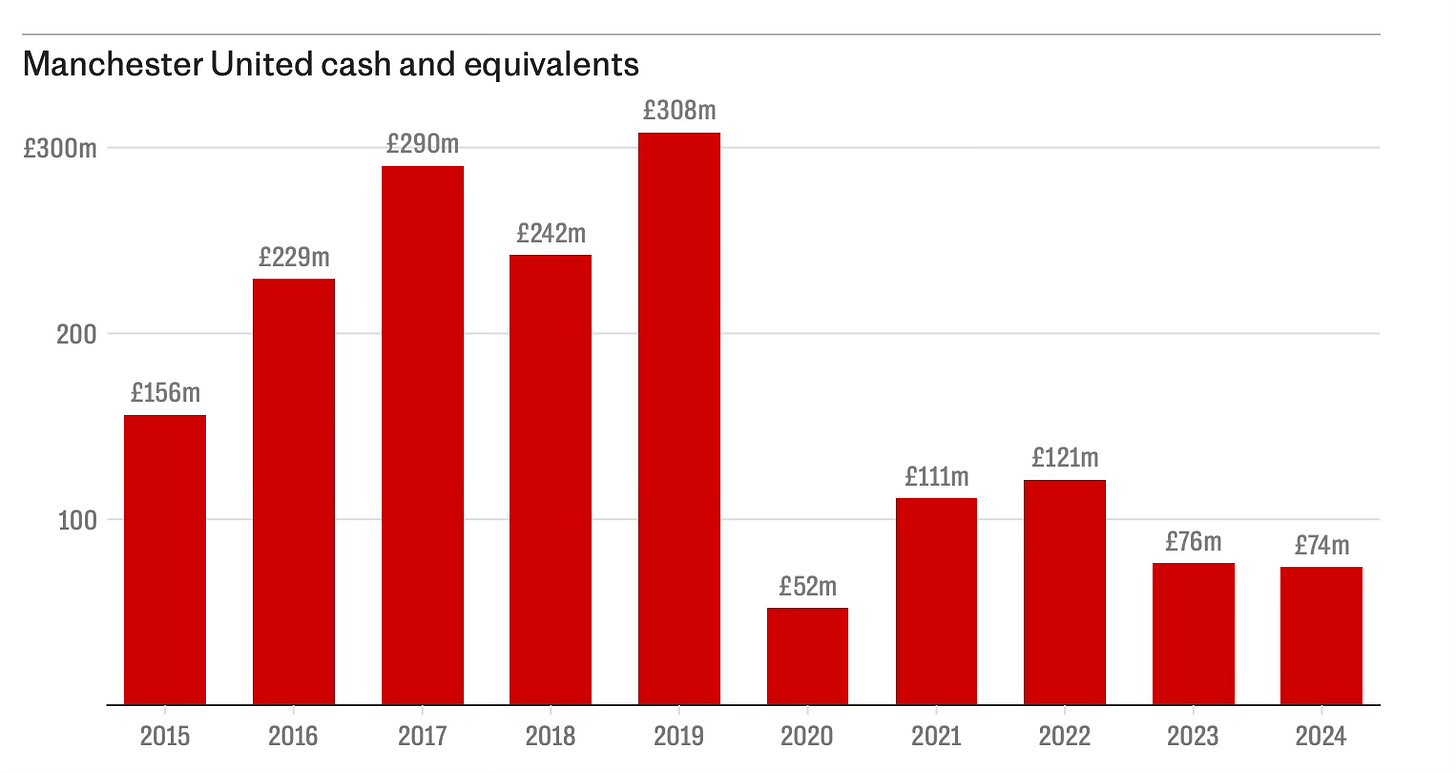This week, United revealed ambitious plans for a landmark infrastructure initiative—a new stadium provisionally called 'New Trafford'—which will replace the iconic yet aging Old Trafford. Led by minority owner Sir Jim Ratcliffe, this massive transformation project signals a decisive shift toward modernity, symbolising the club’s aspiration to cement its position among global football elites for the next century. At least that’s the spin, but what does it really mean for the club’s future and for fans, who are desperate for the team to get back to winning ways.
The Snazzy Launch and the Predictable Response
The announcement dropped on Tuesday was carefully orchestrated, with decision to move forward with a new build—and not a refurbishment of Old Trafford—made last December. The launch placed Sir Jim Ratcliffe prominently at the forefront, with the club’s minority owner outlining his vision for the future, emphasising the need for state-of-the-art facilities that reflect United’s stature in international football. The proposed stadium is designed to hold approximately 100,000 fans, significantly surpassing Old Trafford's existing 74,000-seat capacity, thereby becoming the largest football stadium in the UK and one of the largest globally.
Ratcliffe’s vision highlights the limitations of the current Old Trafford—which have been discussed, mocked and debated ad-infinitum. Big Jim specifically points to United’s ageing infrastructure, amenities that have fallen behind the times, and limitations in spectator comfort and hospitality facilities. Ratcliffe argues that these deficiencies are increasingly obvious when compared to newer stadiums like Tottenham Hotspur’s, Real Madrid’s upgraded Santiago Bernabéu and the rebuild at Camp Nou.
“Today marks the start of an incredibly exciting journey to the delivery of what will be the world’s greatest football stadium, at the centre of a regenerated Old Trafford. Our current stadium has served us brilliantly for the past 115 years, but it has fallen behind the best arenas in world sport. By building next to the existing site, we will be able to preserve the essence of Old Trafford, while creating a truly state-of-the-art stadium. Just as important is the opportunity for a new stadium to be the catalyst for social and economic renewal of the Old Trafford area, creating jobs and investment, not just during the construction phase, but on a lasting basis when the stadium district is complete. The Government has identified infrastructure investment as a strategic priority, particularly in the north of England.” - Sir James Arthur Ratcliffe
The plans promise plenty of fan-friendly facilities, with images dropped at the launch showing steep sided terraces, massive seated areas behind the goals, huge events spaces, and screens galore. The launch also made much of advanced technological integration, including high-speed Wi-Fi, augmented reality experiences, and enhanced accessibility. Beam me up Scotty.
Sustainability is also prioritised through the incorporation of renewable energy sources, rainwater harvesting systems, and reduced environmental footprint goals. Notwithstanding the limited amount of sunshine in Manchester, at least the pitch will get plenty of free water from Sir Jim’s big tent.
More significantly from a finance perspective, plans include significant expansions in VIP and hospitality areas, aligning with contemporary stadium economics. Indeed, the plans call for more than 15,000 executive seats and a promise to use the ground for more than the 25 or so matchdays that Old Trafford is full today.
Lack of Ties to Manchester United's History
Despite the enthusiasm and ambition displayed by club leadership, the proposed modernist architectural style has generated considerable debate among fans, pundits and wannabe architectural experts. Traditionalists argue that the strikingly futuristic design, featuring a distinctive central mast and an umbrella-shaped roof, departs sharply from Old Trafford’s design. Critics contend that such a design, with huge covered event space and hospitality areas, represents commercialisation overshadowing tradition and identity.
This tension exemplifies broader cultural debates within football about balancing modernisation with preserving historical identity. At stake is whether United can maintain its distinct identity amid sweeping changes or if some degree of historical disconnection is an unavoidable consequence of ambition.
Notable by its absence from the many images delivered by the architectural firm Foster & Partners were the lack of references to legendary figures like Sir Alex Ferguson or Sir Matt Busby, as well as famous architectural elements such as the Munich Tunnel and memorial plaque, or the Trinity. Will the old statues be moved and to where? There appeared to be a statue of David Beckham, located by the Ship Canal. More on that waterway to come.
The club did at least offer an image of a museum located in one of the massive covered event spaces.
Fan Groups React
Fan reactions have been notably divided. The Manchester United Supporters Trust (MUST), generally supportive of club progression, nonetheless voiced significant concerns over potential financial implications. They fear, with justification, that escalating costs of stadium development will inevitably increase ticket prices, limiting access for traditional supporters and negatively affecting the unique atmosphere of match days.
"The announcement of plans to build a brand new stadium adjacent to Old Trafford is clearly very big news for United fans. Everyone wants the biggest and the best for our Club and the visuals look both stunning and exciting. But against the backdrop of uncertainty around next year’s ticket prices, continuing poor performance on the field, speculation around sales of key young players, and the recent financial results, the news probably does beg more questions than it gives clear answers. As our own and the club’s consultations have shown, the answer to whether United fans want to refurbish Old Trafford or build a new ground depends entirely on what the consequences of the decision are. "Will it drive up ticket prices and force out local fans? Will it harm the atmosphere, which is consistently fans’ top priority in the ground? Will it add to the debt burden which has held back the club for the last two decades? Will it lead to reduced investment in the playing side at a time when it is so badly needed? - M.U.S.T
The 1958, a more radical supporter group that has organised multiple protests against the Glazer ownership in recent months, strongly criticised the proposed project, labelling the design "circus-like," "soulless" and “generic.” They argue that club executives are prioritising global branding and market expansion over meaningful engagement with fans, potentially weakening the sense of community integral to United’s heritage.




Both groups raised concerns over the club’s transparency, questioning the extent of genuine fan consultation before announcing the plans. Many supporters have expressed fears that the club could become overly commercialised, potentially eroding the emotional connection long-time supporters hold with the club. That feeling is underscored by the understandable fear that the new stadium will be financed through ticket price hikes.
Government, Regeneration, and Planning
The stadium project forms a crucial component of a broader urban regeneration strategy backed by local and national government. United presented stadium plans at both the Conservative and Labour conferences in recent months and have retained close contact with both the Manchester Major—Everton supporting Andy Burnam—and the local council.
Authorities view this initiative as essential to stimulating economic growth, potentially creating thousands of new jobs, attracting significant private investment, and rejuvenating the local area around Old Trafford, which has long been identified as economically disadvantaged.
However, the stadium development faces stringent regulatory scrutiny, especially given its complex location near the Manchester Ship Canal and local housing. Planning approvals will require rigorous adherence to environmental sustainability, careful management of traffic and infrastructure strain, and ensuring community benefits. Negotiations with government planners and local communities will be critical to meeting these requirements.
Among the government aligned, if not directly financed initiatives, will be redeveloping the Old Trafford train station, moving the freight depot nearer to Liverpool, and solving the perennial problem with match day traffic. The Chester Road exit towards the M62 is a notorious pinch-point leading to long delays for fans leaving the stadium. Development traffic will apparently be eased by building stadium components off-site and then transporting them along the Canal.
The government has outlined clear expectations that United must deliver tangible benefits for the local community, including improved transport links, affordable housing initiatives, job creation schemes, and green spaces to enhance public wellbeing. Meeting these commitments will be essential for securing necessary approvals.
Likely Timelines - Ambitious or Wildly Optimistic
United have announced ambitious timelines, targeting project completion by the beginning of the 2030/31 season. Preliminary site preparation and groundbreaking activities could even begin by late 2025 or early 2026, with the main construction phase expected to last approximately three years. During construction, the club aims to minimise disruption, using modular building techniques and exploiting the logistical advantage provided by the proximity to the Ship Canal.
Historical precedent suggests caution; other recent stadium projects, such as Tottenham’s new stadium and Everton’s ongoing development, encountered significant delays, typically stemming from regulatory challenges, environmental impact assessments, and community opposition. Analysts suggest that delays of two to three years are plausible, especially considering the ambitious scope and regulatory complexity involved.
That’s before any debate around the ongoing and future ownership of the club and the challenges in financing the projected £2 billion cost.
Role of Owners or Lack Thereof
The stadium initiative clearly reflects the strategic and growing influence of Ratcliffe on the club, underscoring a significant departure from the Glazer family’s historical approach to club management. Since his acquisition of a minority stake, Ratcliffe has consistently advocated for infrastructure improvements, alongside deep cuts in operational costs and an eye on increased commercial revenue streams. Like him or hate him, Ratcliffe’s leadership style marks a decisive shift away from the Glazers' emphasis on financial extraction.
Indeed, notably absent from active involvement in the project launch were members of the Glazer family, whose 20-year tenure has been marked by total managerial incompetence and a focus on prioritising short-term profitability over long-term investment.
Ratcliffe’s visible leadership in the press on Monday and with the launch on Tuesday highlights a broader shift in club governance, albeit if he wants to rebuild trust and reestablish a vision focused on sustained sporting excellence he will need be out there with fans groups far more often, including leading a deep and ongoing focus on fan consultation.
Financing Options
Perhaps the most controversial part of the New Trafford project is the cost at roughly £2 billion—and we can expect a large overspend as well. It will make it one of the most expensive sports infrastructure projects globally. Financing this investment poses significant challenges, prompting careful analysis of various funding methods. Ratcliffe’s substantial personal resources through the INEOS Group are expected to play a role, but the scale of investment necessitates exploring additional revenue streams.
These could include lucrative naming rights deals, extensive commercial sponsorship arrangements, and partial public funding tied explicitly to broader regional regeneration objectives. Public funding, however, remains politically sensitive and contingent upon demonstrating clear community and economic benefits.
Debt financing, all too familiar from the Glazer era, remains on the table but introduces considerable risk, especially given historical backlash against leveraging club assets. United CEO Omar Berrada has explicitly recognised these risks, emphasising the need for a carefully balanced financial strategy that ensures investment in player recruitment and development alongside infrastructural ambitions.
“We don’t want to inhibit our ability to invest in the team, for us to continue being competitive while we are building a new stadium. There’s various ways around that and one of the things we are looking at is to shorten the construction timelines so we can have a new stadium within five years. That’s our ambition. In the meantime, by getting our finances back in order and becoming profitable, we believe that we can be very competitive. The big, big benefit that this club has is that it has the biggest fanbase in the world and therefore the ability to be the No 1 in terms of revenues that it generates. We’d love to open the new stadium with Ruben as head coach.” - Omar Berrada
Fans should expect a mix of bonds, bank loans, owner-equity financing and naming rights to pay for the project. United certainly don’t have the cash at hand to finance the stadium.
All of it, however, is contingent on whether Ratcliffe can seize a controlling ownership stake in the club. Without that there’s no debt repayment and no owner financing of New Trafford.
And what of the team? With United lying in 14th, the club claiming it is too broke to pay for staff lunch, and Sir Jim suggesting that United could have run out of cash this year but for his capital injection … will Ruben Amorim be afforded the resources to rebuild the team while billions are being spent on a big tent?
It really is the BIG question.







